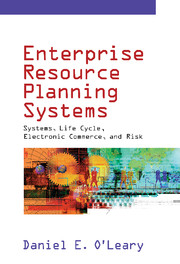Book contents
- Frontmatter
- Contents
- Acknowledgments
- PART ONE INTRODUCTION AND BACKGROUND
- PART TWO ERP SYSTEMS
- PART THREE ERP LIFE CYCLE
- 7 Deciding to Go ERP
- 8 Choosing an ERP System
- 9 Designing ERP Systems: Should Business Processes or ERP Software Be Changed?
- 10 Designing ERP Systems: Choosing Standard Models, Artifacts, and Processes
- 11 Implementing ERP Systems: Big Bang versus Phased
- 12 After Going Live
- 13 Training
- PART FOUR ELECTRONIC COMMERCE AND RISK
- Index
7 - Deciding to Go ERP
from PART THREE - ERP LIFE CYCLE
Published online by Cambridge University Press: 05 June 2012
- Frontmatter
- Contents
- Acknowledgments
- PART ONE INTRODUCTION AND BACKGROUND
- PART TWO ERP SYSTEMS
- PART THREE ERP LIFE CYCLE
- 7 Deciding to Go ERP
- 8 Choosing an ERP System
- 9 Designing ERP Systems: Should Business Processes or ERP Software Be Changed?
- 10 Designing ERP Systems: Choosing Standard Models, Artifacts, and Processes
- 11 Implementing ERP Systems: Big Bang versus Phased
- 12 After Going Live
- 13 Training
- PART FOUR ELECTRONIC COMMERCE AND RISK
- Index
Summary
This chapter analyzes some of the different rationales associated with deciding to go with ERP. In particular, this chapter examines four questions.
(1) What are the business case rationales used for determining whether or not to go ERP, and which are most frequently used?
(2) How can business case rationales be used to facilitate design or measure success?
(3) How do firms measure rationales: in monetary or nonmonetary terms?
(4) How does a firm ultimately decide to go ERP?
Business Case Rationales
Business case rationales for ERP systems can be grouped into four different sets of categories: technology, business process, strategic, and competitive. Each of those rationales has different strengths and limitations. This chapter illustrates rationales from each category.
The choice of business case rationale is important for at least three reasons. First, critical analysis is necessary to ensure that the firm makes the correct decision regarding ERP. Ultimately, that analysis can generate a number of different rationales or arguments used to substantiate ERP adaptation. Second, in some cases, the basis of choice can facilitate ERP design, providing design specificity. For example, if the goal is to improve a specific process then the extent of that improvement can be measured. Third, the basis of choice can facilitate evaluation of the success of the implementation, based on whether the business case rationale was successfully met. Different measurement approaches can provide a basis for determining success.
- Type
- Chapter
- Information
- Enterprise Resource Planning SystemsSystems, Life Cycle, Electronic Commerce, and Risk, pp. 89 - 101Publisher: Cambridge University PressPrint publication year: 2000

